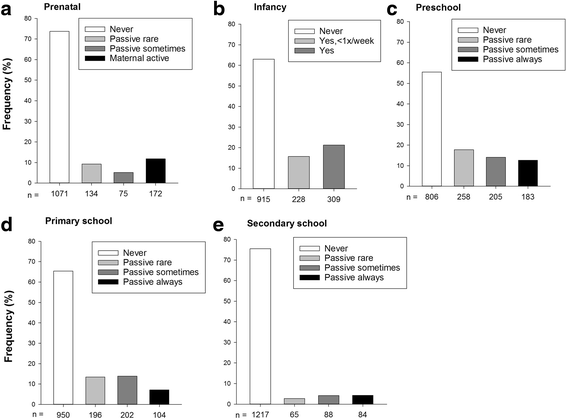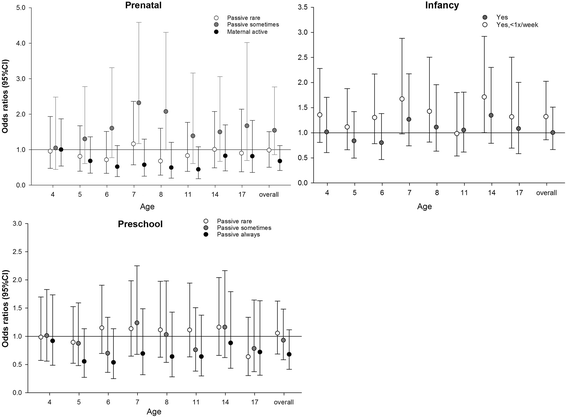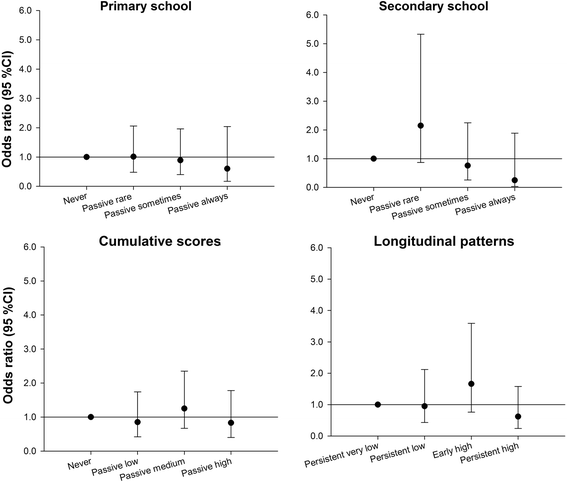Lifetime secondhand smoke exposure and childhood and adolescent asthma: findings from the PIAMA cohort
- PMID: 28231798
- PMCID: PMC5324208
- DOI: 10.1186/s12940-017-0223-7
Lifetime secondhand smoke exposure and childhood and adolescent asthma: findings from the PIAMA cohort
Abstract
Background: Secondhand smoke (SHS) exposure is a modifiable risk factor associated with childhood asthma. Associations with adolescent asthma and the relevance of the timing and patterns of exposure are unclear. Knowledge of critical windows of exposure is important for targeted interventions.
Methods: We used data until age 17 from 1454 children of the Dutch population-based PIAMA birth cohort. Residential SHS exposure was assessed through parental questionnaires completed at ages 3 months, 1-8 (yearly), 11, 14, and 17 years. Lifetime exposure was determined as; a) time window-specific exposure (prenatal, infancy, preschool, primary school, and secondary school); b) lifetime cumulative exposure; c) longitudinal exposure patterns using latent class growth modeling (LCGM). Generalized estimation equations and logistic regression were used to analyze associations between exposure and asthma at ages 4 to 17 years, adjusting for potential confounders.
Results: With all three methods, we consistently found no association between SHS exposure and asthma at ages 4 to 17 years e.g. adjusted overall odds ratio (95% confidence interval) 0.67 (0.41-1.12), 1.00 (0.66-1.51) and 0.67 (0.41-1.11) for prenatal maternal active smoking, infancy, and preschool school time window exposures, respectively.
Conclusion: We assessed lifetime SHS exposure using different methods. Different timing and patterns of SHS exposure were not associated with an increased risk of asthma in childhood and adolescence in our study. More longitudinal studies could investigate effects of lifetime SHS exposure on asthma in adolescence and later life.
Keywords: Asthma; Environmental epidemiology; Longitudinal data; Secondhand smoke.
Figures




Similar articles
-
Timing of secondhand smoke, pet, dampness or mould exposure and lung function in adolescence.Thorax. 2020 Feb;75(2):153-163. doi: 10.1136/thoraxjnl-2019-213149. Epub 2019 Nov 20. Thorax. 2020. PMID: 31748257
-
Pre- and postnatal exposure to parental smoking and allergic disease through adolescence.Pediatrics. 2014 Sep;134(3):428-34. doi: 10.1542/peds.2014-0427. Pediatrics. 2014. PMID: 25136039
-
Tobacco Smoke Exposure, Airway Resistance, and Asthma in School-age Children: The Generation R Study.Chest. 2015 Sep;148(3):607-617. doi: 10.1378/chest.14-1520. Chest. 2015. PMID: 25741773
-
The association between secondhand smoke and childhood asthma: A systematic review and meta-analysis.Pediatr Pulmonol. 2020 Oct;55(10):2518-2531. doi: 10.1002/ppul.24961. Epub 2020 Jul 24. Pediatr Pulmonol. 2020. PMID: 32667747
-
Effects of secondhand smoke exposure on asthma morbidity and health care utilization in children: a systematic review and meta-analysis.Ann Allergy Asthma Immunol. 2015 Nov;115(5):396-401.e2. doi: 10.1016/j.anai.2015.08.005. Epub 2015 Sep 26. Ann Allergy Asthma Immunol. 2015. PMID: 26411971
Cited by
-
Maternal smoking during infancy increases the risk of allergic diseases in children: a nationwide longitudinal survey in Japan.Allergy Asthma Clin Immunol. 2025 Jan 16;21(1):4. doi: 10.1186/s13223-025-00952-9. Allergy Asthma Clin Immunol. 2025. PMID: 39825417 Free PMC article.
-
Maternal Smoking during Pregnancy and Early Childhood and Development of Asthma and Rhinoconjunctivitis - a MeDALL Project.Environ Health Perspect. 2018 Apr 12;126(4):047005. doi: 10.1289/EHP2738. Environ Health Perspect. 2018. PMID: 29664587 Free PMC article.
-
Health effects associated with exposure to secondhand smoke: a Burden of Proof study.Nat Med. 2024 Jan;30(1):149-167. doi: 10.1038/s41591-023-02743-4. Epub 2024 Jan 9. Nat Med. 2024. PMID: 38195750 Free PMC article.
-
Burden of diseases attributable to second-hand smoke exposure in Iran adolescents from 2009 to 2020.Sci Rep. 2023 Aug 21;13(1):13605. doi: 10.1038/s41598-023-40058-z. Sci Rep. 2023. PMID: 37604845 Free PMC article.
References
-
- US Surgeon General: The Health Consequences of Smoking: 50 Years of Progress. A Report of the Surgeon General. Atlanta (GA): US Department of Health and Human Services. Centers for Disease Control and Prevention, Coordinating Center for Health Promotion, National Center for Chronic Disease Prevention and Health Promotion, Office on Smoking and Health; 2014. http://www.surgeongeneral.gov/library/reports/50-years-of-progress/full-.... Accessed 16 Jun 2016.
Publication types
MeSH terms
Substances
LinkOut - more resources
Full Text Sources
Other Literature Sources
Medical

